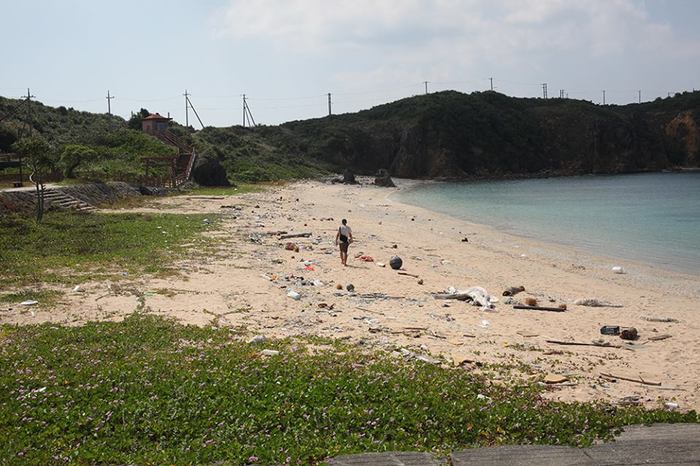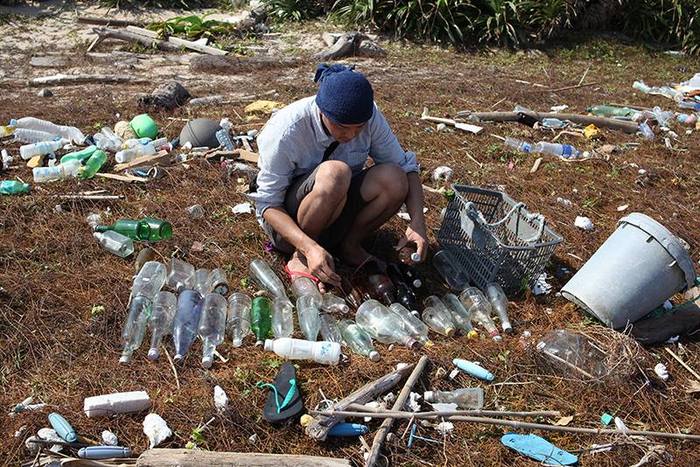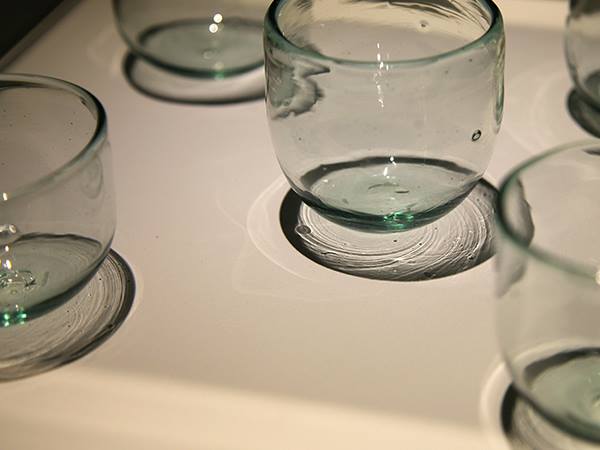ガラスの旅 Glass journey


沖縄と八重山諸島を旅した。
台風19号の後だということもあり、美しいビーチはゴミの山だった…。ペットボトルや発泡スチロールが多く、その他にも漁業の道具やビーチサンダルや生活用具など。台湾、中国、韓国、東南アジアなど、様々な国から色々な物が流れて来ていた。
旅のなかで、島々の海岸を漂着物を見ながら歩くことを日課にすると、すぐに風景の風景の見え方が変わっていった。まずは、漂着物が多い海岸とそうではない海岸があることに気がつく。理由は様々あるが、季節風や観光の為の清掃や海岸の地形などが関係するようだ。もうひとつ気がついたのは、実は少なくない人数が、頻繁に海岸の漂着物を見て何かを集めてまわっていること。朝、浜辺に新しくできた漂着物のラインには必ず新しい足跡が残されている。西表島のある海岸で出会った人は、海岸に打ち寄せた藻を集めて干していて、「肥料として畑に蒔くとトマトが美味しくなる」と話す。その他、漂着物の中で種子やおもちゃを集めている人や漂着物を組み合わせてお土産物を作っている人々や様々な人々にも出会って、いろいろな話しを聞く事ができた。全く知らない世界と住人がいることに気がついた。
数ヶ月前、福岡県の玄界灘の海岸を歩き続ける漂着物の第一人者石井忠さんにお話を聞く機会があった。「漂着する木は、かつては集めて薪にしたり、海辺の社は寄木や寄船で造営されることもあった」と話されていた。さらに、「見つけた物が大きすぎる場合、石をのせて印を付けたり、隠したりするが、再び戻ると無くなっていることがある。」と悔しそうに話されていた。
海の幸は、漁で取れる魚介類だけではなく、浜辺に寄せる物も生活の資源になるし海の幸だ、ということを感じた。そして、そう考えるとペットボトルや発泡スチロールが簡単に再生できないのは非常に残念に思えてくる。
沖縄には様々な国から様々な物が流れつく宿命をもった地理。船も人も文化も流れてくるし、文化も侵略者も…。ニライカナイという沖縄の思想には、海の向こうから神が豊かさをもたらしまた帰るとされる。沖縄という土地は様々な善くも悪くも「寄せるもの」を受け入れ、付き合って来た(編集してきた)歴史がある。武器ではなく、生きる力で戦って来たように感じる。
沖縄には琉球ガラスの工房が沢山ある。琉球ガラスの歴史は、明治時代に長崎や大阪からやってきたガラス職人によって始まったが、戦後は、進駐軍が使用し廃棄されたコーラやビールの瓶を材料に再生ガラスとして彼らのお土産用の器が作られ始め、現在に至る。現在でも多くの工房は、コーラの瓶にかわり泡盛の空き瓶を回収して再生し食器を作っている。
「海に流れ着く様々な漂着瓶でガラス食器が作れないか?」そんなことを思い、海岸に流れ着くガラス瓶を集めるようになった。漂着する瓶から再生ガラスを作る。調べたり相談してまわると、そこにはふたつ大きな問題が出てきた。「ガラスは種類によって膨張係数が違うので、色々なガラスを混ぜると必ず破れること」と「工房のガラスの窯の坩堝に外から持ち込んだ色々な見知らぬガラスを入れることは大変な労力のいることで、やってくれる職人はいないのではないか」ということ。
普通に使用するのにむずかしい食器は職人は作らない。使えない食器、などあり得ない。ただ、形成した後、ガラスが破れてしまうことも含めて興味が湧いて来た。そして何よりガラスに関わる人が口を揃えて「破れるからやった事はない」と聞いていると、逆に作ってみたい気持ちをかき立てられた。
制作協力をお願いできる職人さんを捜した結果、奇跡的に興味を持って協力して頂ける方に出会うことができた。素敵な出会いの連鎖だった。
拾い集めたガラスボトルは、ハンマーで砕いた。炉の中に入れ、1日かけて溶かした。翌日、職人さんの指導で溶けたガラスを吹いて食器を作る。熱せられ赤々と光るガラスにはいくつものスジが見え、職人さんは「これは混ぜたからだし、普通より吹いた時にも丸くなりにくいな」と話した。
出来上がった食器を除冷を行いさらに翌日、工房に行く。制作した食器は破れていなかった。「混ぜ合わした様々なガラスの相性が偶然良かったのかも。奇跡的」と。少し亀裂が入る事を期待していたこともあり、少し複雑な気持ちで見ていると、「これから数ヶ月後に突然破れる事もあるよ」と職人さんは言った。
ガラスは固まっているように見えて、非常に流動性のある存在だという。陶芸は土と言う生ものを焼くことで固める感覚があるが、ガラスは少し逆の感覚を受けた。漂着したぼろぼろの瓶は窯で焼かれ新しくより生なものに生まれ変わったように、緊張感がある。
出来上がったグラスに光に当てると、置いた台に、様々な瓶の混ざりあわないガラスの層が影として見えて、非常に美しい。何より、実際に見えないが、このコップの中に様々な場所や時間が混ざりあっているということが、不思議な気持ちにさせる。
出来上がったグラスの中の2つを自宅に持ち帰り、家で乾杯した。洗っている時に、コップの中に少し亀裂がピキッと入った。嬉しいような悲しいような気持ちになった。
Glass journey
I traveled around the Yaeyama islands following the typhoon 19. The beautiful beach was covered in a mountain of garbage such as bottles and polystyrene foam, fishing tools, beach sandals, and the various objects of everyday life that came flowing from Taiwan, China, Korea, and Southeast Asia.
In the itinerary of my journey, I planned to walk routinely. Watching the flotsam in the coast, I immediately began to perceive the landscape differently. First, I noticed that there are some coasts with a lot of flotsam and others with little. The reasons were various: the effects of the monsoon and cleaning up the beach for tourism purposes, as well as geographical features. Also, I noticed that people frequently walked around and collected things from the seaside. Every morning, the beach was left with fresh footprints in the new line of flotsam. People I met at the seaside in Iriomote Island collected algae that washed up on the shore and dried it. They said that “it makes tomato delicious if you spread it in the field as fertilizer.” In addition to that, I met people who were picking up the seeds and toys, and people were making souvenirs by combining and attaching flotsam. I heard various stories and encountered people who live in the world that I have never known.
A few months ago, I had the opportunity to meet and listen to Mr. Tadashi Ishii: a leading scholar in flotsam who has investigated around the Genkai coast in Fukuoka. He stated that “trees, washed ashore and collected, used to be used as firewood. The seaside shrine was also constructed from broken ships and drifting woods.” He continued, “If I find objects that are too large, I mark them by placing a stone or hiding them, but I find them gone when I go back again.” He told me this in a regretful way, I thought. The blessing from the sea means that it is not only seafood that can be taken in (via fishing) but also those things that come to the coast. I felt that it was very regrettable that the polystyrene foam and PET bottles cannot be recycled easily.
Okinawa’s geography had a destiny whereby various things have flowed into it from various countries. With ships also flowed culture, invaders...
In Okinawa, the legend of Niraikanai states that God comes to bring blessings from the other side of the sea and then returns. The land of Okinawa also has a history that has accepted the “things posting,” and edited them not by weapons but by the vitality of the people in a peaceful way.
In Okinawa there were a lot of Ryukyu glass workshops. The history of Ryukyu glass was begun by glass artisans who came from Nagasaki and Osaka in the Meiji era. After the war, they began to produce glassware souvenirs using glass discarded by the army who had occupied the area. Still in present day, many of the workshops are recycling glass from empty bottles of Awamori instead of Coke bottles.
I wondered whether it would be possible to make glassware by recycling materials from the bottles washed ashore. Two important problems emerged after I examined and consulted on this possibility. I was told that “because of the large variety and different expansion coefficient of glass types, mixing the glass always causes it to break.” Also, “it takes a great effort to put glass of various origins into a crucible of kiln glasses brought from the outside. Therefore, no craftsman wants to try it.”
It is reasonable that a craftsman does not make dishes that are difficult to use in daily life. There cannot be a table where that table cannot be used. However, what I found most interesting was the process; including the possibility for the glass to break after it had been formed with success. All those involved in glass production say, “never try it, as it will break.” In reverse, I had the feeling that I wanted to try. As a result of looking for a craftsman who could cooperate with me throughout the production, I was able to meet a person who was interested in my attempt and helped me miraculously. It was a nice bond to encounter. I crushed gathered glass bottles with a hammer, put them in a furnace, and dissolved them over one day. The next day, I blew glass melted under the guidance of craftsmen. Heated and shining brightly in red, several streaks appeared inside the glass. The craftsmen said, “Since different types of glass were mixed, it becomes difficult to form round when it blows normally.”
The following day, after cooling the formed glasses, I went to workshop and found them not broken. I thought, “It is a miraculous coincidence that these different types of glass have good chemistry.” I had expected some to have cracks, and for me to be disappointed. Nevertheless, the craftsman said that “there is probability that they will be broken by chance after a few months.”
Glasses can seem to be solidified but consist of very fluid substances. Pottery solidifies by burning raw soil, but I felt that the glasses differed. The bottles washed ashore and worn, then burned in the kiln, were reborn, as if something like new life were emerging and bringing with it a vivid tension.
When I looked upon the completed glass, there appeared to be a very beautiful shadow, projected through layers of components that were completely melted. More than anything, it was actually invisible. Various locations and various times were mixed inside this cup, and this brought me mysterious feelings.
I brought home two of the glasses and toasted with them. A little crack began to appear in one of the cups when I was washing it. I felt a little sad but a little happy.
November 17, 2014
